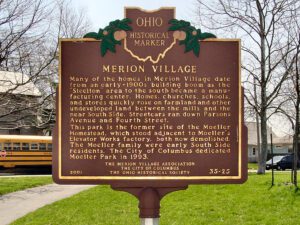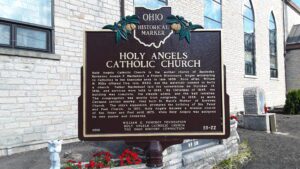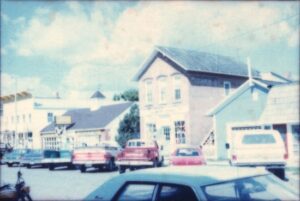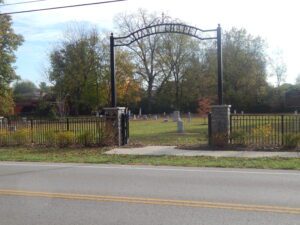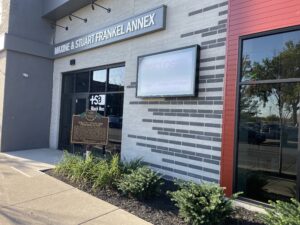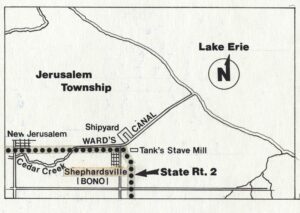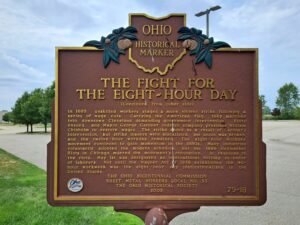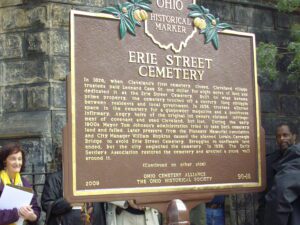, OH
Merion Village was named for the Nathaniel Merion family, who in 1809 settled what is now the South Side of Columbus on 1800 acres of the Refugee Lands. Entrepreneur William Merion operated “Merion’s Landing” in the 1830s to capitalize on the canal trade from the Columbus Feeder Canal. This area saw a large influx of German immigrants as the South Side industrialized in the mid-nineteenth century. Later, many Irish, Italian, and eastern European immigrants who worked in the local steel mills and foundries made their homes here.
, OH
Holy Angels Catholic Church is the mother church of Sandusky. Reverend Joseph P. Machebeuf, a French Missionary, began ministering to Catholics in the Sandusky area in late 1839. Soon after, William H. Mills offered five lots, $530, and the materials needed to build a church. Father Machebeuf laid the cornerstone on October 13, 1841, and services were held in 1842. By Christmas of 1845, the building was complete, the steeple added, and the bell installed. The congregation was mostly Irish emigrants. In 1855, as more Germans settled nearby, they built St. Mary’s Mother of Sorrows Church. The city’s expansion prompted the building of Sts. Peter and Paul Church in 1871. Holy Angels became a mission church of Sts. Peter and Paul until 1875 when Holy Angels was assigned its own pastor and reopened.
, OH
Born in Rhode Island, John Pray (1783-1872) moved to the Maumee River Valley from New York shortly after serving in the War of 1812 and completing a prospecting tour in Ohio. He built a dam across the river to Granger Island and in 1821 constructed a water-powered gristmill, the first on the lower Maumee. In 1831, he laid out the Village of Waterville with the first 50 lots. The Columbian House, a stagecoach inn constructed by Pray in 1828 and expanded in 1837, was for years the commercial and social center of Waterville and accommodated travelers from cities such as Detroit and Cincinnati. From this building, he operated the village’s post office. When Wood County was organized in 1820, Pray became a commissioner until Lucas County was formed from part of Wood in 1835. For nine years he served as Justice of the Peace in Waterville. He and his wife Lucy raised eleven children to adulthood. Circa 1854 he constructed his home, which today overlooks Pray Park.
, OH
Around 1843, local Methodists organized a new Methodist Episcopal church at Fair Play and later erected a brick chapel. The congregation was short-lived, however, and fell into decline after one of its leading members, Joseph Lashorn, moved to Hamilton. In 1876, Reverend F. G. Grigsby of the United Brethren church organized a congregation here, repairing and occupying the old Methodist chapel for the next several years. The cemetery is the burial place for veterans from the Revolutionary War, War of 1812, and Civil War; some of whom are interred in unmarked graves. The last known burial was Etta Thomas in 1941.
, OH
Willys-Overland Finishing Plant. Since 2004, the building at 14th and Adams Streets has been the home of the Toledo School for the Arts. The Willys-Overland Corporation erected the building c. 1916 to finish, ship, and sell the company’s cars. The popular Whippet and other models were delivered here to a second story loading dock from the Willys plant along what became Jeep Parkway. Vehicles were displayed behind floor-to-ceiling windows in a first floor showroom. The firm of Mills, Rhines, Bellman, and Nordoff designed the building and others in Toledo during the first third of the 20th century. In 1908, John North Willys (1873-1935) consolidated his company’s automobile production in Toledo. By 1912, Willys-Overland sales were second only to the Ford Motor Company’s. The company’s most famous product is the Jeep, which transported Allied service members from WWII to the 1980s and was a precursor to the sports utility vehicle.
, OH
To utilize the area’s rich timber stands, Detroit industrialist Eber Brock Ward (1811-1875) built a canal around 1870 in what was then Oregon Township, Lucas County. Known as Ward’s Canal, it stretched approximately 2-3/4 miles through wetlands to Lake Erie. Through the canal passed timber sawn at Ward’s mills and ships from his boatyards. Two settlements formed to house workers: Shepherdsville, renamed Bono in 1898, and New Jerusalem. (Continued on other side)
, OH
Organized efforts to establish an eight-hour workday existed as early as 1866 in the United States. The Cleveland Rolling Mills Strikes of 1882 and 1885, as part of this almost-70-year struggle, contributed to the establishment of the eight-hour workday. Both strikes challenged the two-shift, twelve-hour workday in addition to seeking recognition of the Amalgamated Association of Iron, Steel, and Tin Workers. The first strike – by English, Welsh, and Irish skilled workers – was at the Newburgh Rolling Mills, a major producer of steel rails for the rapidly expanding railroad industry that once stood near this site. It was quickly broken when unskilled Polish and Czech immigrants, unaware of the ongoing labor dispute, were hired. The strike ended when these new workers did not support the union. (continued on other side)
, OH
In 1826, when Cleveland’s first cemetery closed, Cleveland village trustees paid Leonard Case Sr. one dollar for eight acres of land and dedicated it as the Erie Street Cemetery. Built on what became prime property, the cemetery touched off a century long struggle between residents and local government. In 1836, trustees allotted space in the cemetery for a gunpowder magazine and a poorhouse infirmary. Angry heirs of the original lot owners claimed infringement of covenant and sued Cleveland, but lost. During the early 1900s Mayor Tom Johnson’s administration tried to take back cemetery land and failed. Later pressure from the Pioneers’ Memorial Association and City Manager William Hopkins caused the planned Lorain Carnegie Bridge to avoid Erie Street Cemetery. Struggles to confiscate land ended, but the city neglected the cemetery. In 1939, The Early Settler’s Association restored the cemetery and erected a stone wall around it. (continued on other side)


